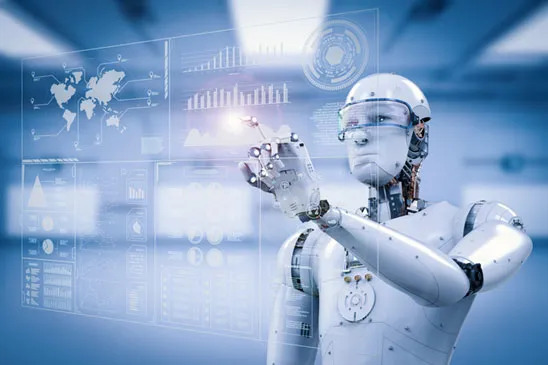
Emerging Trends in Robotics and Automation Technology for 2024
Last updated on April 6th, 2024 at 06:19 am
Robotics and automation technology have made significant strides over the years, changing sectors and how we work and live. Looking into the future, 2024 is set to mark another year of unbelievable innovation in the robotics and automation world. Indeed, as the years unfold, there seems to be no imminent slowdown in the transformation of the robotics and automation sector. Through AI advancements and the rapid improved use of collaborative robots, there are a couple of detainer robotics and automation trends across the industry, which we will discuss in this article.
1. Artificial Intelligence (AI) and Machine Learning
Artificial intelligence and machine learning make a significant contribution to the development of robotics and automation. The progress in AI algorithms will allow robots to “think” more intelligently in 2024 that enabling better perception of the environment and interaction with it. Moreover, machine learning will make robots experience-based, behaving independently in changing conditions, and self-adapting to perform versatile and intricate tasks. AI and machine learning create high potential for the development of robotic systems, from self-driving cars to robotic machines.
2. Collaborative Robots (Cobots)
In 2024, many more industries will be employing C cobots, or collaborative robots Definitions: “Cobots are robots that work with people in a shared environment and can safely and efficiently execute repetitive or hazardous tasks . They are currently being used more successfully with the most intelligent equipped with sophisticated sensors and software and use artificial intelligence and machine learning to detect and respond to human presence Collaboration between humans and machines have never been easier and quicker. Cobots also increase productivity to improve ergonomics. This makes manufacturing processes more agile because Cobots always work at top speed. Manufacturing, p. 441).
3. Autonomous Vehicles and Drones
Autonomous vehicles and drones are regarded among the most imperative innovations across the field of robotics and automation. By 2024, we should expect more major progress in autonomous driving technologies. Self-driving vehicles, trucks, and delivery vans should become increasingly visible on the roads and highways. Drones should also become sufficiently utilized in aerial photography and video recording, agriculture, and package distribution, among others. Enhanced navigation, obstacle avoidance, and communication systems among other systems should ensure greater efficiency, security, and convenience with these two pieces of equipment.
4. Human-Robot Interaction (HRI)
Human-robot interaction is a research field that aims to integrate intuitive and natural interactions for the human-robot experience. By 2024, HRI technologies will make rapid strides in enhancing the ability of robots to more efficiently respond to human speech, gestures, and expressions. This will help humans and robots work together more fluidly and seamlessly in homes, at hospitals, and in offices. Given their increasing importance in modern society, intuitive HRI interfaces will become invaluable in promoting user acceptance and integration.
5. Soft Robotics and Bio-inspired Design
Soft robotics and bio-inspired design are new fields that focus on making robots that are flexible, adaptive, and robust by emulating nature. By 2024, there will be significant enhancements in soft robotic technology to create machines that can work in unstructured spaces, handle fragile tools, and interact safely with human beings. Moreover, bio-inspired designs such as animal movements and biomechanics will develop robotic models that use less power and are stronger and more versatile compared to conventional robots.
6. Robotics-as-a-Service (RaaS)
Businesses will progressively access robotic solutions through the Robotics-as-a-Service model. By 2024, RaaS offerings are bound to rise and thus become the way many small and medium enterprises and startups interact with robotics. RaaS will be used to provide, among other things, a variation of robotic solutions, from industrial robots and service robots to autonomous vehicles designed and adapted to a variety of industries. This model will bring robotics technology closer to the people and lead to its integration into various industries.
7. Edge Computing and Robotics
Edge computing is a form of circulated computing that spreads computational resources closer to the source of data, resulting in less latency and the ability to procedure data from sensors in real time. In 2024, this technology will be highly crucial in robotics applications in situations necessitating low latency and high reliability, including autonomous vehicles, as well as industrial automation. With the help of edge computing, robots will be able to make faster, more smart decisions, greatly increasing their activity and efficiency.
Conclusion
Since 2024 and even later, the future is already more than promising. Artificial intelligence accelerated its development in four or more places, collaborative robots walk around the park, and drones and other automatic vehicles are as often as personal cars. The overwhelming desire to overtake everything and everyone gives reason to say that, in order not to be left behind, new technologies and developments need to be promptly tracked. No puzzle will be so difficult as not to be conquered with the right tactics, discipline, and investment without loss. The period of smart automation is already around the corner.
Read Dive is a leading technology blog focusing on different domains like Blockchain, AI, Chatbot, Fintech, Health Tech, Software Development and Testing. For guest blogging, please feel free to contact at readdive@gmail.com.
